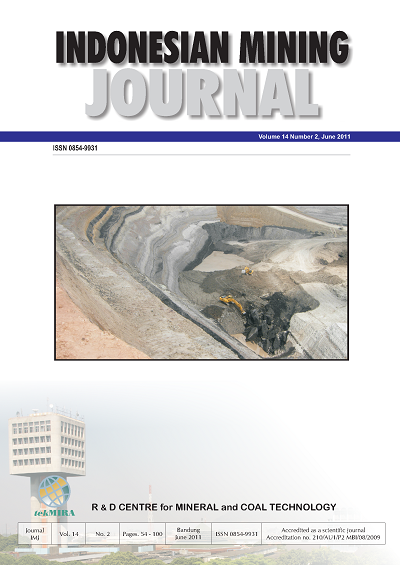Indexed by:
Vol. 14 No. 2 (2011): INDONESIAN MINING JOURNAL Vol. 14 No. 2 June 2011

This current journal focuses in metal and non-metal minerals and coal technology. The industrial minerals are interesting to discuss, because their existence is not attractive for mining investors due to their poor quality. However, they are abundant in quantity. They are easily found and well observed in all parts of this country. Ironically, these minerals have been imported until now, particularly from China and India. For this reason, Indonesia has already issued the new law on mineral and coal mining (Law Number 4/2009), which is accommodative for the mining business. For instance, the government has tried to construct infrastructure to access the locality of the com- modities. The most important thing is that prior to exporting, the minerals must be processed to be good commodities and not as raw materials in order to improve its technology and national rev- enue. Coal in Indonesia, especially from Kalimantan and Sumatera, is huge in the quantity. Its potential becomes a major future primary energy source due to its quality and quantity that is prospectively utilized in the future. However, most of the coals have low ranks. That is why this low rank coals should be evaluated to select the appropriated utilization technologies. In order to improve quality and value added, the mineral and the coal must be totally processed prior to utilising and exporting in accordance with the above new law.
Mineralogical characters of epithermal vein deposits were carried out in the research. According to its mineral content and vein deposit types, mineralization in the studied area occurred in two stages, which are early epithermal process producing comb-vuggy vein deposit and final epithermal deposit retaining chalcedony vein deposit. Zone of prospective mineralization is situated within vein and rocks beneath and above veins. This mineralogical character is very specific in the area, and it is very useful to locate the prospective zone.
Geologic aspects controlling maceral and mineral matter content of coal is shown in the study. Megascopically, the coal is dominated by bright-banded and banded. Microscopically, vitrinite and liptinite are the dominant macerals in the coal. Inertinite is a minor component. Mineral con- tent is relatively high in most of the coal. This is an important relationship between megascopic and microscopic studies. The brighter coal is in association with the vitrinite-rich coal. The differ- ences in the coal type are because of the interaction of geologic factors. There is a good correlation among lithotype, petrographic composition and geologic aspects, which clearly influence the char- acteristics of the coal.
The effect of hydrogen pressure on the preparation of artificial caking coal for coke binder is seri- ously investigated in the study. Coals from selected areas in Sumatera and Kalimantan were used as raw material for the making of binder. Observation includes influence of hydrogen pressure on the total carbon content, ash content and free swelling index. The result indicates that all non-caking coals used in the experiment can be converted into caking coal for the use as a binder in the making of coke.
Extraction of potassium from feldspar and leucite, presented in this journal, discusses the policy that is related to the framework of eliminating dependency on import. The import rate is stagnantly high, and it is caused by factors of unwise policy and interest conflict from the stakeholders. The issuance of Law Number 4/2009 on mineral and coal mining is expected to be the critical moment for reforming the policy and related regulations.











